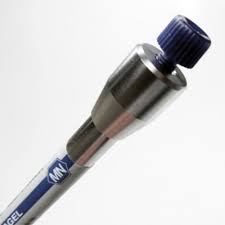


Base material NUCLEOSIL® silica, particle size 5 μm, pore size 100 Å modified cyclodextrins as chiral selectors
NUCLEODEX β-OH: β-cyclodextrin (R = H; n = 2) ∙ USP L45
Separation based on hydrogen bonds and dipole interactions between functional groups of the analyte and hydroxyl groups of the cyclodextrin
Examples for successful enantiomer separations: chlorthalidone and other compounds, which require free hydroxyl groups for enantioselective interactions
Eluent in column CH3OH – 0.1 % TEAA pH 4 (55:45)
NUCLEODEX α-PM: permethylated α-cyclodextrin (R = CH3; n = 1)
For all permethylated phases the ability to form hydrogen bonds is reduced, the hydrophobicity of the phase is increased compared to β‑OH, resulting in shorter retention times .
Examples for successful enantiomer separations: mecoprop and dichlorprop as free carboxylic acids, trans-stilbene oxide and styrene oxide
Eluent in column CH3OH – 50 mM phosphate pH 3 (70:30)
NUCLEODEX β-PM:permethylated β-cyclodextrin (R = CH3; n = 2) ∙ USP L45
Examples for successful enantiomer separations:
mephobarbital (prominal), pesticides derivatives mecoprop-methyl et fenoxaprop-ethyl
Eluent in column CH3OH – 0.1 % TEAA pH 4 (65:35)
NUCLEODEX γ-PM:permethylated γ-cyclodextrin (R = CH3; n = 3)
Examples for successful enantiomer separations:
steroids or other larger molecules
Eluent in column CH3OH – 0.1 % TEAA pH 4 (55:45)
NUCLEODEX phases are especially suited for the control of optical purity, but also for semipreparative separations and for the analysis of positional and cis-trans isomers.

